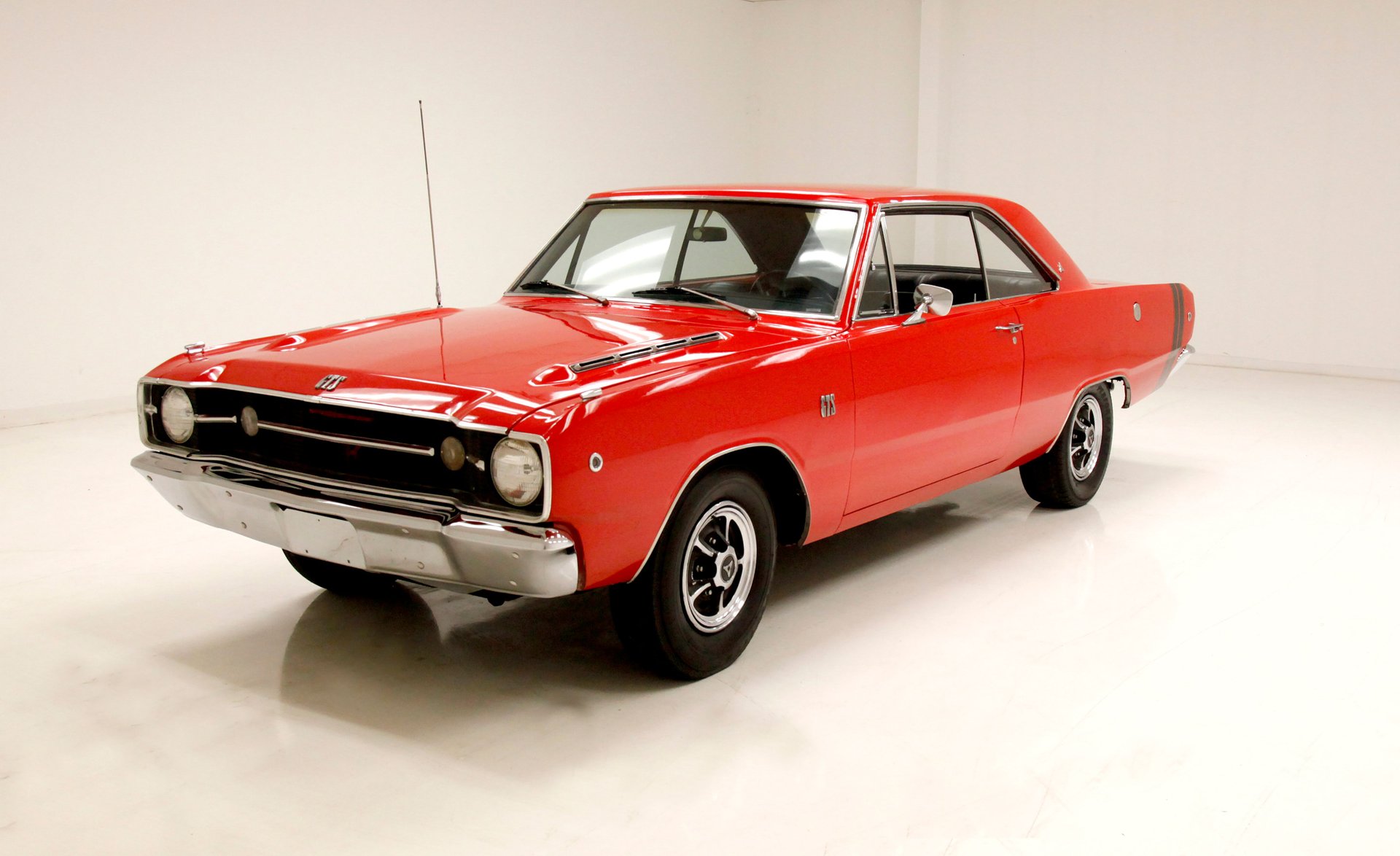The Dart GTS was among the original members of Dodge’s “Scat Pack” in 1968, marked by the distinctive “bumblebee” stripe that wrapped around the rear of the car.
The Scat Pack’s symbol was an automotive bee, a unique branding choice that gave Dodge an edge in the competitive muscle car market.
The Dart GTS was essentially an enhanced Dart GT, boasting a high-performance suspension, a standard 340-cubic inch high-revving small-block engine, with an optional 383-cubic inch big-block engine available for an additional cost, and E70 x 14 tires.
Many buyers preferred the lighter 340 engine, as it weighed 89 pounds less than the big block, improving handling. Both engine options made for an impressive ride.
Although the Dart “GT” first debuted in 1965, it wasn’t until the 1967 model year that Dodge raised the stakes with added premium features offered as optional extras, with the GTS serving as the top model, available initially only with the 383 engine.
The 1967 Dart lineup included both a 2-door hardtop (LS23) and a convertible (LS27). In 1968, the new 340 engine became standard, with GTS badging on the hood, front fenders, interior door panels, and decklid.
Design details included a hood with simulated intake ports, a unique center grille appliqué on early models, and the standard bumblebee rear stripe, offered in red, white, and black, or a horizontal side stripe that ran along the car’s length.
Dubbed the “giant killer from Hamtramck,” the 340 engine had a 4.04-inch bore and 3.31-inch stroke, making it a high-revving powerhouse capable of hitting peak performance at 5,500 rpm.
It featured 10.5:1 compression ratio pistons and a forged steel crankshaft, while high-strength connecting rods allowed up to 6,500 rpm, supported by a double-roller timing set for durability.
The 340 engine also included performance-enhancing elements like a factory-installed windage tray, dual-point ignition, free-flowing cylinder heads with large valves (2.02-inch intake, 1.60-inch exhaust), and high-load valve springs.
A low-restriction exhaust manifold, a 600-cfm Carter AVS four-barrel carburetor, a low-restriction air cleaner, and a viscous-drive fan rounded out this formidable package.
Two hydraulic camshafts were available for the 340 engine—one for automatic transmissions and another for 4-speed manuals.
The camshaft for automatics had .430/.445 lift, 268/276 degrees duration, and 44 degrees of valve overlap, while the manual camshaft had .445/.455 lift, 276/284 degrees duration, and 52 degrees of valve overlap.
These variations allowed Dodge to better regulate idle in TorqueFlite® automatic models. Options for the Dart GTS included a wood-grain steering wheel, center console, radio, and bucket seats (bucket seats were standard in the GTS hardtop but optional for convertibles).
The featured model also has an original 1968 air conditioning system salvaged from another vehicle. Over time, a Pioneer head unit was added to allow for cassette playback.
In Dodge factory terminology, “LS27” referred to the Dart Convertible. This model was ordered with a red body, a white top, a matching white interior, and the characteristic white bumblebee stripe across the back.

Built on a 111-inch wheelbase, the convertible version weighed in at 3,275 pounds. Optional front and rear bumper guards were also included in this model.
One option for styling the 1968 Dodge Dart GTS convertible was to choose the “PP1” Bright Red color, as shown on this featured model’s fender tag.
The Dart was generally not seen as a high-performance car, but the GTS option changed that perception. Dodge advertising had fun with the new image, declaring, “The Scat Pack Compact.
When you buy a compact, you get a compact engine, right? Wrong! Not since Dart GTS. This is a new breed that boosts a 340-cube, 4-barrel V8.
That’s standard. There’s also an optional 383 4-barrel. Doesn’t sound like a kiddy-car, does it? It doesn’t look or ride like one, either. It handles beautifully. That’s Dart GTS!”
There is little documentation on the “center piece” grille detail on early Dart GTS models, but all promotional materials and photos of 1968 GTS cars show it.
However, models built after January 1, 1968, may have been delivered to dealerships without this feature.
Federal safety regulations in 1968 also led to the addition of side marker lights, giving the car a slightly more sophisticated look with fender-mounted turn indicators.
The individual at Dodge who envisioned the “Bumblebee stripes for Scat Pack” in 1967 was indeed inspired. In that era, the sight of a Dodge sporting these stripes signaled a true performance vehicle.
While the stripes primarily served an aesthetic purpose, the special GTS hood added an appearance of enhanced performance.
From the factory, the car came with E70-14 Red Stripe tires. This particular car, though not a daily driver, has been updated for roadability with P255/70R-14 BFGoodrich T/A Radials and is equipped with full-size “Mag Look” wheel covers.
The fender tag provided key details about the vehicle’s configuration: “L” for Dart, “S” for Special Price Class, “27” for convertible, “52” for 340 4BBL engine, “39” for E70 x 14 Wide Tread Tires, “S4W” for Black/White interior, and “PP1” for Bright Red.
Attention to authenticity is evident in details like the Mopar® Group 24 battery, the vintage-style Mopar air cleaner housing sticker, and the Carter AVS carburetor (although a replacement, it closely resembles the original), all contributing to a factory-correct appearance.
The promotional materials for the Dodge Dart GTS highlighted its unique appeal.
The brochure described the car with flair: “The first thing everybody notices about GTS are its Bumblebee stripes in black, red or white, and hood power bulges.Visible clues to the kind of performance magic you can expect from GTS.
If you’re the sneaky type, you can have a fine-line side stripe or leave the stripes off altogether and pretend it’s an ordinary machine. Until, of course, you tromp your foot down.”
In the April 1968 issue of *Hot Rod Magazine*, the editors reviewed a 340-cid GTS hardtop with a TorqueFlite automatic transmission and 3.55:1 rear axle gearing.
They took it to Orange County International Raceway (OCIR), filling it with a full tank of fuel and inflating the E70-14 tires to 33 psi.
Shifting manually at 6,000 rpm, they made a dozen quarter-mile runs, with the best time being 14.38 seconds at 97 mph.
This setup, which retained the air cleaner housing but removed the air filter, offered as close to “pure stock” performance as you could get in those days.

